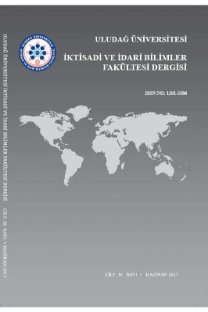Testing the probability distribution models for the patients' lengths of stay in hospital
Hastanede yatma süreleri için olasılık dağılımı modellerinin test edilmesi
___
Aytaç, M. (2004),Matematikselİstatistik,Ezgi Kitabevi,Bursa.Bai, X., Kwok, T. C. Y., Ip, I. N., Woo, j., Chui, M. Y. P. ve Ho, F. K. Y. (2014),Physical restraint use and older patients length of hospital stay, Health Psychology & Behavioural Medicine ,2(1), s.160-170.
Chassin,M. R. (1983),Variations in Hospital Length of Stay: Their Relationship to Health Outcomes, Health Technology Case Study: 24, Ota Publishing.
Clauset, A.,Shalizi, C. H. ve Newman, M. E. J. (2009), Power -law distributions in empirical data, 51(4), s.661-703.
Esatoğlu, A. E. ve Bozat, S. (2002), Survey on the Length of Stay for the Patients with Chronic Obstructive Pulmonary Disease: An Application on Atatürk Chest Disease Hospital, Journal of Ankara Medical School,24(4), s.165-176.
Faddy, M., Graves, N. ve Pettitt, A. (2009), Modeling Length of Stay in Hospital and Other Right Skewed Data: Comparison of Phase -Type, Gamma and Log- Normal Distributions, Value in Health ,12(2), s. 309-314.
Goldstein,M. L.,Morris, S. A. & Yen, G. G. (2004), Problems with Fit ting to Power-law Distribution, European Physical Journal B,41(2), s.1-4.
Hellervik,A. & Rodgers,G. J. (2007) A power law distribution in patients lengths of stay in hospital, Physica A,379, s. 235-240.
Keefler, J., Duder, S. ve Lechman, C. (2001), Predicting Length of Stay in an Acute Care Hospital: The Role of Psychosocial Problems ,Social Work in Health Care,33(2), s.1-16.
Lee, W., Chiu, W., Tsai, S., Lin, M., Chu, S. ve Lam, C. (2010), Comparison of Length of Hospital Stay Between Taipei City and Hualien Country in Spinal Trauma Patients,J Exp Clin Med, 2(5), s.239-244.
Lim, A.& Tongkumchum,P. (2009), Methods for Analyzing Hospital Length of Stay with Application to Inpatients Dying in Southern Thailand, Global Journal of Health Science,1(1), s.27-38.
Marazzi, A., Paccaud, F. &Ruffieux, C. (1998), Fitting the distributions of length of stay by parametric models, Medical Care, 36(6), s.915-927.
Mitzenmacher,M. (2003), A Brief History of Generative Models for Power Law and Lognormal Distributions,Internet Mathematics, 1(2),s.226-251.
Newman,M. E. J. (2005), Power Laws, Pareto Distributions and Zipfs Law, Contemporary Physics,46(5), s.323-351.
Rafiei, M., Ayatollahi, S.M.T. & Behboodian, J. (2007), Length of Hospital Stay at Arak Maternity Clinics Using Proposed Zero -Inflated Negative Binomial Modeling,Pakistan Journal of Biological Sciences , 10(15), s. 2510-2516.
Ravi,A. ve Butar, F. B. (2010), An Insight to Heavy-Tailed Distribution, Journal of Mathematical Sciences & Ma thematics Education,5(1), s.1-15.
Xiao, J., Lee, A. H. & Vemuri, S. R. (1999),Mixture distribution analysis of length of hospital stay for efficient funding, Socio-Economic Planning Sciences,33, s. 39-59.
- ISSN: 1301-3386
- Yayın Aralığı: Yılda 2 Sayı
- Başlangıç: 2018
Avrupa birliğinde parasal süreç ve euro krizi
Testing the probability distribution models for the patients' lengths of stay in hospital
Necmi GÜRSAKAL, SELİM TÜZÜNTÜRK, ZEHRA BERNA AYDIN
Avrupa birliği'nde siyasi faaliyetlerin kamu kaynaklarından desteklenmesine ilişkin düzenlemeler
HÜSEYİN GÜL, İBRAHİM ALPER ARISOY
Türkiye'de döviz kurunun enflasyon üzerine geçiş etkisinin ekonometrik analizi: 19872011
Kobi'lerin rekabet gücünü artırmada ar-ge faaliyetleri: Bursa analizi
Mehmet ÇINAR, SİMLA GÜZEL, FİLİZ GİRAY, MEHMET YÜCE
